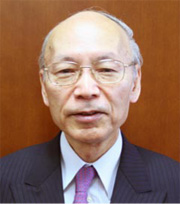Home > Highlighting JAPAN > Highlighting Japan JANUARY 2012 > Science & Technology: What's the Plan?
Highlighting JAPAN
COVER STORY: Tomorrow's World
Science & Technology: What's the Plan?
In August 2011, the 4th Science and Technology Basic Plan was determined at a meeting of the Cabinet. The Japan Journal's Osamu Sawaji spoke with Dr. Masuo Aizawa, executive member of the Council for Science and Technology Policy, who was involved with the Plan's development.

Dr. Masuo Aizawa, executive member of the Council for Science and Technology Policy
Credit: THE JAPAN JOURNAL
Please tell us the key points of the 4th Science and Technology Basic Plan.
Dr. Masuo Aizawa: The government formulates the Science and Technology Basic Plan every five years for specifically promoting measures concerning Japan's science and technology in line with the Science and Technology Basic Law that went into force in 1995. The 4th Science and Technology Basic Plan (the "Plan") was supposed to start in April 2011, but the Great East Japan Earthquake struck in March just before it, so its details were reconsidered.
There are four key points of the Plan that was decided by the Cabinet in August 2011. The first point is utilizing science and technology to achieve recovery and reconstruction from the earthquake. The second is, through promotion of science and technology innovation, resolving issues that Japan and the world face. The third is dramatically strengthening basic research and developing human resources who will play a role in advancing science and technology. And the fourth is promoting science and technology innovation policy by closely cooperating with the citizens. We aim to increase research and development (R&D) investment by both the government and the private sector to 4% of the GDP or more, out of which we will strive to increase the government's R&D investment to 1% of the GDP. This will bring the government's total R&D investment to around 25 trillion yen for the next five years.
What sort of science and technology measures will be promoted based on lessons from the Great East Japan Earthquake?
The Great East Japan Earthquake is, so to speak, a challenge from nature. In order to deal with this challenge, we need to comprehensively observe changes in nature on the global scale. To this end, improving the global observation network by satellite both in ocean and terrestrial areas will lead to protection from natural disasters such as earthquakes and tsunamis.
The Great East Japan Earthquake caused great damage to supply chains supporting manufacturing, and agriculture and fisheries, and it is necessary to not only return them to their original state but also reconstruct these industries to be resilient to natural disasters. This includes, for instance, plant factories capable of high-足productivity and stable agricultural production using cutting-edge technologies, and research and development of complete fish culture.
The Plan includes the promotion of "green innovation." Specifically, what kind of R&D measures does it contain?
Green innovation aims at both achieving a low carbon society in response to climate change and securing stable energy supply.
As for key energy supply, for example, R&D measures are needed to further reduce carbon dioxide emissions in thermal power generation and renewable energy must be vigorously promoted in consideration of the future of nuclear power generation.
The Plan also incorporates innovation of a distributed energy system. This targets a dramatic reduction of energy consumption through realization of smart houses and smart communities; that is, where power is generated by technologies such as solar power and fuel cells at the location where the power is consumed, is stored in accumulators, and then used efficiently through energy management, such as through the use of a smart grid.
Similarly, what types of R&D measures are included in "life innovation" listed in the Plan?
Research by Japanese scientists has revealed how diseases occur and how the immune system works in the body, and how cells are differentiated. Innovative methods for preventing diseases and developing treatment are being achieved based on the results of this research.
For example, iPS cells, which were discovered by Dr. Shinya Yamanaka, a professor at Kyoto University, are expected to contribute greatly to regenerative medicine and drug discovery. The cell sheets developed by Dr. Teruo Okano, a professor at Tokyo Women's Medical University, have the potential to fundamentally change conventional treatment. If cell sheets are transplanted into an organ that requires treatment, the transplanted cells will increase and help the organ to recover its functions.
In 2010, the Government launched the Funding Program for World-Leading Innovative R&D on Science and Technology (FIRST Program), and it supports the research of top Japanese scientists.
How should Japan contribute to the world in the areas of science and technology in the future?
In 2025, the global population will have increased from the current seven billion people to eight billion. Asia's population will account for about two-thirds of this. Environmental and energy issues are therefore expected to grow increasingly serious. From this perspective, the Plan includes promotion of the concept of the East Asia Science and Innovation Area, for the purpose of jointly conducting R&D that will help overcome issues common to Japan and Asian countries, and bolster the development of human resources in Asia. Since Japan is experienced with issues such as the environment and aging, and takes the lead in related measures, it should take a leadership role and contribute to other Asian countries so that we are able to rely on each other.
© 2009 Cabinet Office, Government of Japan






